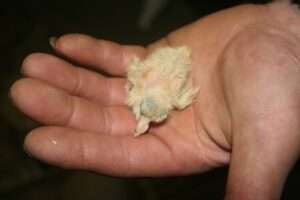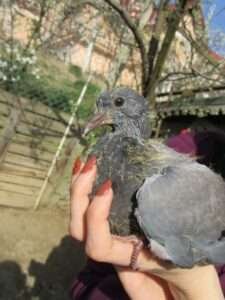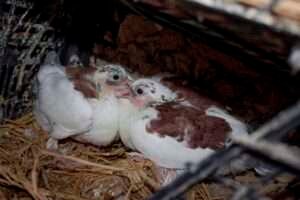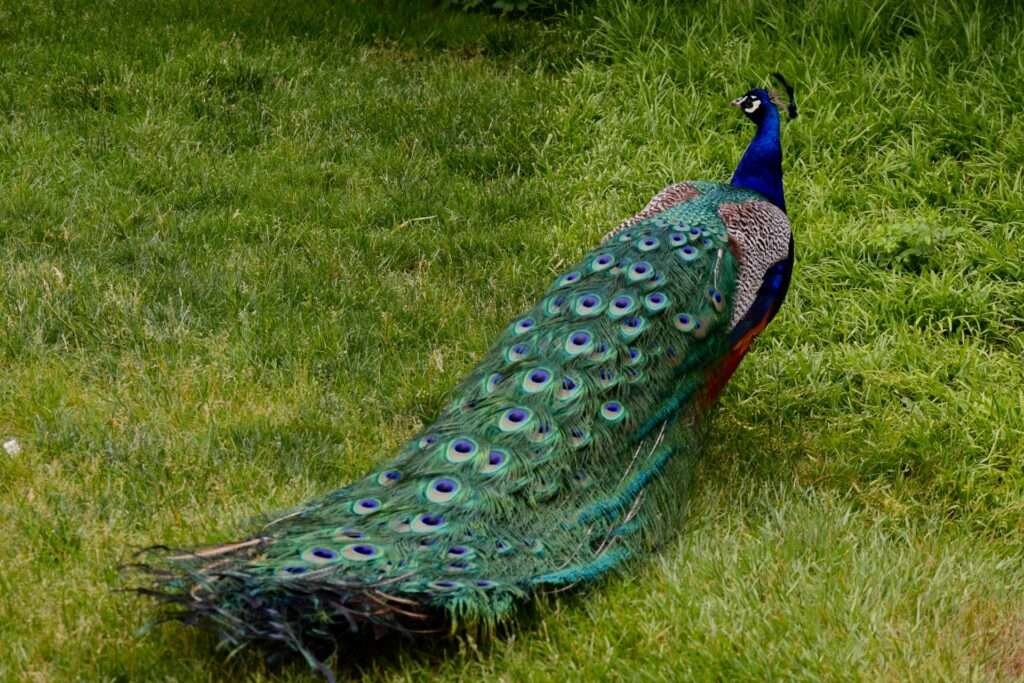Due to their nesting habits, baby pigeons, also known as squabs, are rarely visible. Parents often keep them hidden until they’re nearly fully grown.
Baby pigeons, also known as squabs, spend their early lives tucked away in nests located in secluded spaces, such as high ledges, building cavities, or dense foliage. Their absence from public view sparks curiosity—many wonder why they don’t spot juvenile pigeons as frequently as other birds.
Parents care for squabs attentively for up to six weeks, an unusually long period for birds. This extended rearing period allows the young pigeons to fully develop before braving the outside world. Given their vulnerable state, parents provide consistent warmth and sustenance, which includes a special ‘crop milk’—a nutrient-rich substance produced in the parent’s digestive tract. With this level of care, baby pigeons have a greater chance of survival, emerging from their nests when they resemble adults, effectively camouflaged within the pigeon population.
What Do Baby Pigeons Look Like?

Despite their commonplace presence in urban environments, many people have never seen a baby pigeon, which leads to curiosity about their appearance. The soft, yellowish down covers newly hatched pigeons, also known as squabs, and their large, bulging eyes often appear disproportionate to their tiny, bobbing heads.
Their skin appears thin and almost translucent, with developing pin feathers that eventually blossom into the grey, sleek feathers associated with adult pigeons. Unlike the vibrant plumage of adults, these juvenile birds maintain a more muted colour palette, aiding in camouflage while they remain nestled and hidden away in their nests high up on ledges or other secluded spots.
Soft peeping sounds might be the only indicator of their presence until they fledge and venture out into the world, growing rapidly to resemble their adult counterparts.
Feeding baby pigeons
Caring for baby pigeons necessitates a nuanced approach, especially regarding their nutrition. These fledglings thrive on a diet meticulously prepared to mimic the regurgitated crop milk they would normally receive from their parents. Enthusiasts and rehabilitators often use a high-protein formula suitable for the species, ensuring the mixture is at a safe, consumable temperature similar to that of the parent bird’s crop.
Feathers and strength quickly become evident with the right feeding schedule, usually several times daily for the first few weeks of life. As growth progresses, the intervals between feedings can be extended, and the diet is gradually adapted to include seeds and grains, paving the way for a seamless transition to independence.

Baby Pigeon Behaviour
Understanding baby pigeon behaviour can reveal fascinating insights into the early life stages of these city-dwelling birds that are often overlooked because their nesting habitats are out of plain sight. Fledglings, or ‘squabs,’ as they are sometimes called, remain in the nest for a considerable period, relying entirely on their parents for sustenance and warmth.
The parent birds primarily feed them “pigeon milk,” a nutrient-rich substance. With growth, these young birds start to develop the grey, fluffy plumage characteristic of juvenile pigeons. Rarely seen by the general public, squabs spend most of this time gaining strength until they are ready to venture out and practice flying, which is a critical step towards independence.
Observing these creatures’ gradual transition from dependency to self-reliance is a reminder of the nurturing behaviours inherent in the animal kingdom.
Fostering Baby Pigeons

Fostering baby pigeons requires attentive care to ensure their health and survival. Initiating this process, one should create a warm and safe environment, replicating the coziness of a nest. Proper nourishment is paramount; a formula specific to squabs should be administered regularly.
During this period, observe the fledglings for signs of growth and vitality, such as weight gain and feather development. Engaging with them can also promote their socialization and prepare them for eventual release. Remember, cleanliness around the feeding area is crucial in preventing diseases.
Dedication to these nurturing practices is fundamental to giving these juvenile birds a robust start in life.
When Baby Pigeons Leave the Nest
Understanding the developmental journey of pigeons can be fascinating. Typically, squabs, as baby pigeons are known, remain nestled cozily within their nests for a duration of about a month. During this period, their primary activities involve growing and gaining the strength necessary for survival outside their safe haven.
Parents take turns feeding them a nutritious secretion known as ‘crop milk’, which is pivotal for their growth. As fledglings become more robust, their curiosity about the world outside the nest increases, and they begin practising flapping their wings to build muscles.
Eventually, this preparation culminates in the young birds taking tentative steps out of their nest as they depart to explore their surroundings and learn the intricate skills of foraging on their own, marking the start of their independent lives.
Frequently Asked Questions About Baby Pigeons
Why Don’t We See Baby Pigeons?
Baby pigeons, or squabs, stay hidden in their nests until they’re nearly adult-sized. Pigeon parents select secluded nesting spots high above the ground, keeping the young out of sight to ensure their safety.
How rare is it to see a baby pigeon?
Seeing a baby pigeon is rare because they usually stay in their nests until they resemble adults.
How Long Does It Take Baby Pigeons to Leave the Nest?
Baby pigeons, also known as squabs, typically leave the nest about 25 to 32 days after hatching.
What do pigeon babies look like?
Pigeon babies, or squabs, are born with soft, yellowish-down feathers and a disproportionately large beak. Typically, they close their eyes and appear weak and helpless in the initial days after hatching.
Conclusion
Unveiling the often unseen life of baby pigeons has been a journey of discovery. These elusive nestlings grow rapidly, hidden from view, before emerging as familiar city dwellers. Understanding their unique start in life deepens our appreciation for these common birds, enriching our urban wildlife experience.
Embrace curiosity, and keep an eye skyward—you might just spot a fledgling taking its first flight!




